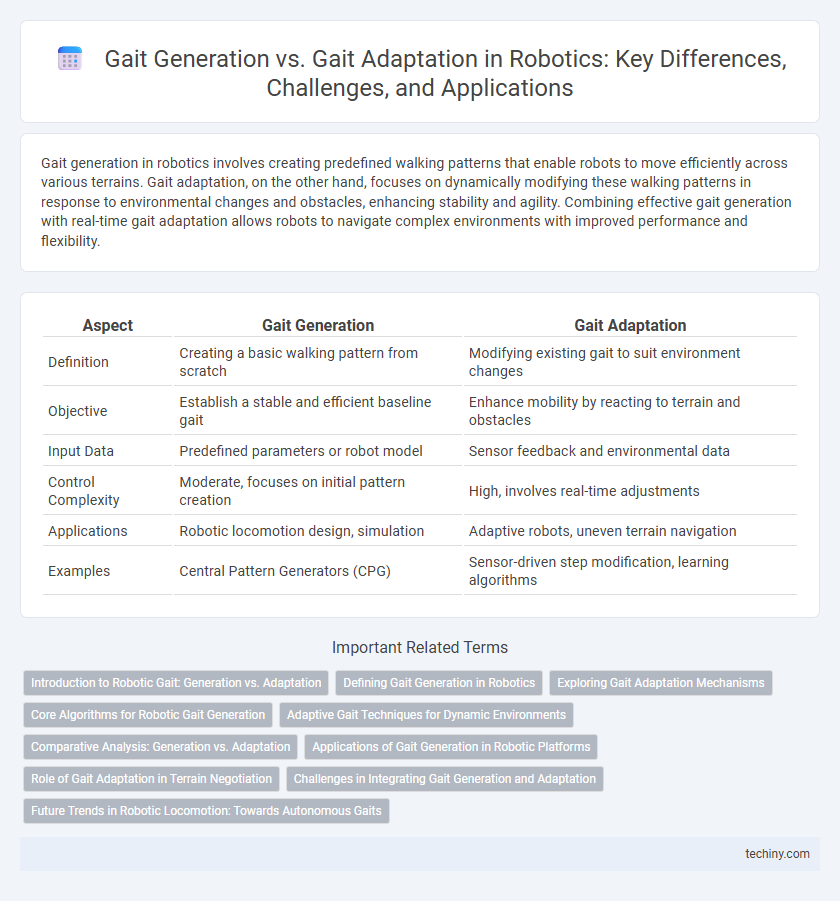Gait generation in robotics involves creating predefined walking patterns that enable robots to move efficiently across various terrains. Gait adaptation, on the other hand, focuses on dynamically modifying these walking patterns in response to environmental changes and obstacles, enhancing stability and agility. Combining effective gait generation with real-time gait adaptation allows robots to navigate complex environments with improved performance and flexibility.
Table of Comparison
| Aspect | Gait Generation | Gait Adaptation |
|---|---|---|
| Definition | Creating a basic walking pattern from scratch | Modifying existing gait to suit environment changes |
| Objective | Establish a stable and efficient baseline gait | Enhance mobility by reacting to terrain and obstacles |
| Input Data | Predefined parameters or robot model | Sensor feedback and environmental data |
| Control Complexity | Moderate, focuses on initial pattern creation | High, involves real-time adjustments |
| Applications | Robotic locomotion design, simulation | Adaptive robots, uneven terrain navigation |
| Examples | Central Pattern Generators (CPG) | Sensor-driven step modification, learning algorithms |
Introduction to Robotic Gait: Generation vs. Adaptation
Robotic gait generation involves creating pre-defined movement patterns tailored to specific locomotion tasks, relying on mathematical models and control algorithms to produce efficient and stable motions. In contrast, gait adaptation dynamically modifies these patterns in response to changing environmental conditions or unexpected disturbances, enhancing the robot's ability to maintain balance and maneuver complex terrains. Effective robotic locomotion integrates both generation and adaptation processes to achieve robustness and versatility in real-world applications.
Defining Gait Generation in Robotics
Gait generation in robotics involves creating predefined movement patterns that enable robots to walk or traverse environments efficiently. It focuses on designing algorithms that produce optimal step sequences, timings, and trajectories tailored to the robot's mechanical structure and intended tasks. This foundational process contrasts with gait adaptation, which modifies these patterns reactively based on environmental feedback.
Exploring Gait Adaptation Mechanisms
Exploring gait adaptation mechanisms involves real-time adjustments to robotic locomotion patterns based on sensory feedback and environmental changes, enhancing stability and efficiency. Unlike static gait generation, gait adaptation continuously refines the robot's movements to respond to uneven terrain, obstacles, or dynamic tasks. These adaptive strategies leverage machine learning algorithms and sensor fusion to optimize walking, running, or climbing capabilities in complex settings.
Core Algorithms for Robotic Gait Generation
Core algorithms for robotic gait generation primarily rely on central pattern generators (CPGs), inverse kinematics, and trajectory optimization to produce stable and efficient locomotion patterns. Gait generation focuses on creating predefined walking sequences based on mathematical models and sensory inputs, optimizing parameters like step length, frequency, and joint angles. These algorithms enable robots to execute consistent, energy-efficient movements before any adaptation to environmental changes or perturbations occurs.
Adaptive Gait Techniques for Dynamic Environments
Adaptive gait techniques in robotics enable robots to modify their walking patterns in real-time based on sensory inputs from uneven or unpredictable terrains. These methods utilize machine learning algorithms and sensor fusion to optimize stability, energy efficiency, and obstacle negotiation. Unlike static gait generation, adaptive approaches improve mobility and robustness, crucial for dynamic environments such as disaster response and exploration missions.
Comparative Analysis: Generation vs. Adaptation
Gait generation involves creating locomotion patterns from scratch using predefined models or optimization algorithms, emphasizing reproducibility and predictability in robotic movement. Gait adaptation modifies existing locomotion patterns in real-time to respond to environmental changes or perturbations, enhancing robustness and flexibility in dynamic settings. Comparative analysis reveals that gait generation prioritizes efficiency and baseline performance, while gait adaptation focuses on resilience and situational responsiveness in robotics.
Applications of Gait Generation in Robotic Platforms
Gait generation in robotic platforms is essential for creating pre-defined movement patterns that enable stable and efficient locomotion across structured environments such as factories and warehouses. This process leverages algorithms to produce cyclic leg motions, optimizing energy consumption and speed for tasks like material handling and inspection. Applications include humanoid robots, quadrupeds, and hexapods used in controlled settings where predictable terrain allows for consistent gait execution without immediate need for environmental feedback.
Role of Gait Adaptation in Terrain Negotiation
Gait adaptation enables robots to dynamically adjust their locomotion patterns to varying terrain conditions, enhancing stability and maneuverability on uneven or unpredictable surfaces. Unlike gait generation, which produces basic movement sequences, gait adaptation integrates sensor feedback and environmental data to optimize foot placement and body posture in real-time. This capability is critical for effective terrain negotiation, reducing the risk of falls and improving overall robotic performance in complex environments.
Challenges in Integrating Gait Generation and Adaptation
Integrating gait generation and gait adaptation in robotics involves challenges such as maintaining stability while ensuring real-time responsiveness to environmental changes. Balancing the computational complexity of generating optimal gait patterns with adaptive modifications requires efficient algorithms capable of seamless transitions. Addressing sensor noise and unpredictable terrain further complicates the synchronization of planned gaits with adaptive behaviors.
Future Trends in Robotic Locomotion: Towards Autonomous Gaits
Future trends in robotic locomotion emphasize autonomous gaits that combine gait generation and gait adaptation for improved efficiency and versatility. Advanced algorithms enable real-time adjustment of gait patterns based on sensory input, enhancing adaptability to varying terrains and environmental conditions. Integration of machine learning and neural networks drives the evolution of self-optimizing locomotion systems, pushing robots toward fully autonomous movement capabilities.
Gait Generation vs Gait Adaptation Infographic

 techiny.com
techiny.com